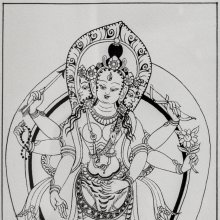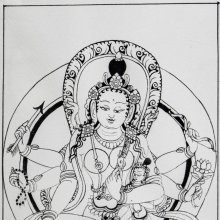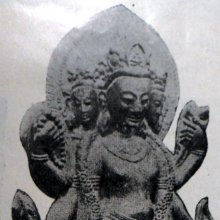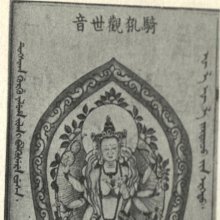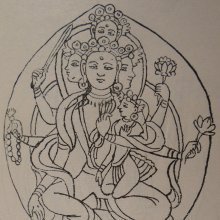Halahala, Halāhala, Hālāhala, Halahalā, Hālahala, Hālāhāla: 23 definitions
Introduction:
Halahala means something in Buddhism, Pali, Hinduism, Sanskrit, Jainism, Prakrit, Marathi, Hindi. If you want to know the exact meaning, history, etymology or English translation of this term then check out the descriptions on this page. Add your comment or reference to a book if you want to contribute to this summary article.
Alternative spellings of this word include Halahal.
Images (photo gallery)
In Hinduism
Purana and Itihasa (epic history)
Source: archive.org: Puranic EncyclopediaHālāhala (हालाहल).—A sect of asuras, who were the first creation of the Trimūrtis, when they also possessed the power of creation. The Hālāhalas, who became very powerful within a short period of time earned from Brahmā all the boons they wanted, and they then conquered the three worlds. At last they barricaded Kailāsa and Vaikuṇṭha also, and Hariharas (Viṣṇu and Śiva) defeated them after a fierce fight lasting for a thousand years. The Hariharas returned to their abodes and spoke about their achievements. Their wives laughed at the bravado of their husbands. At this Mahāviṣṇu got angry with Lakṣmī and Śiva with Pārvatī, and in protest the Devīs left their husbands. From that day onwards Viṣṇu and Śiva began losing their power. Brahmā, who divined the reason for the growing weakness of Viṣṇu and Śiva persuaded Lakṣmī and Pārvatī to return to their husbands so that they might regain their former power. Yet, Brahmā told them that in future he alone would handle the work of creation. Thus was Viṣṇu and Śiva divested of their right to creation. (Devī Bhāgavata, 7th Skandha).
Source: Cologne Digital Sanskrit Dictionaries: The Purana Index1a) Hālāhala (हालाहल).—(Hālāhalam)—the poison that first issued from the Amṛtamathana. Śiva consumed it with Pārvati's permission. That which was split became poisonous scorpions, serpents, cobras and other plants;1 administered to Prahlāda.2
1b) The XI battle between the Gods and the Asuras.*
- * Brahmāṇḍa-purāṇa III. 72. 75, 86.
1c) The eleventh of the twelve incarnations in Vārāha kalpa;1 Vṛtra killed by Mahendra.2
1d) A son of Ariṣṭakarman, and father of Palalaka.*
- * Viṣṇu-purāṇa IV. 24. 46-7.
Hālāhala (हालाहल).—According to Purāṇic texts hālāhala poison came out on the surface when the milky ocean was churned by gods and demons. In order to save the world from the danger Śiva consumed it. Pārvati, his consort sees that it rests in his neck and will not descend down to his stomach. By the time she could put her hand under the effect of the poison Śiva has nausea and reclines. His consort comes to fan him etc. Śiva consumption of the poison is a common story recounted in many purāṇa texts but his reclining is rarely mentioned.

The Purana (पुराण, purāṇas) refers to Sanskrit literature preserving ancient India’s vast cultural history, including historical legends, religious ceremonies, various arts and sciences. The eighteen mahapuranas total over 400,000 shlokas (metrical couplets) and date to at least several centuries BCE.
Shaktism (Shakta philosophy)
Source: Shodhganga: Iconographical representations of Śiva (shaktism)Hālāhala (हालाहल) or Hālāhalatantra refers to one of the twenty Bhūtatantras, belonging to the Śāktāgama (or Śāktatantra) division of the Āgama tradition. The Śāktāgamas represent the wisdom imparted by Devī to Īśvara and convey the idea that the worship of Śakti is the means to attain liberation. According to the Pratiṣṭhālakṣaṇasamuccaya of Vairocana, the Śāktatantras are divided into to four parts, the Hālāhala-tantra belonging to the Bhūta class.

Shakta (शाक्त, śākta) or Shaktism (śāktism) represents a tradition of Hinduism where the Goddess (Devi) is revered and worshipped. Shakta literature includes a range of scriptures, including various Agamas and Tantras, although its roots may be traced back to the Vedas.
Ayurveda (science of life)
Toxicology (Study and Treatment of poison)
Source: Shodhganga: Kasyapa Samhita—Text on Visha ChikitsaHālāhala (हालाहल) refers to one of the six kinds of Viṣa (venom or poison), according to the Kāśyapa Saṃhitā: an ancient Sanskrit text from the Pāñcarātra tradition dealing with both Tantra and Viṣacikitsā—an important topic from Āyurveda which deals with the study of Toxicology (Viṣavidyā or Sarpavidyā).—Kāśyapa, praising the efficacy and potency of the Garuḍa-mantra states that it annihilates poison even as the sun destroys darkness.

Āyurveda (आयुर्वेद, ayurveda) is a branch of Indian science dealing with medicine, herbalism, taxology, anatomy, surgery, alchemy and related topics. Traditional practice of Āyurveda in ancient India dates back to at least the first millenium BC. Literature is commonly written in Sanskrit using various poetic metres.
In Buddhism
Tibetan Buddhism (Vajrayana or tantric Buddhism)
Source: Wisdom Library: Tibetan BuddhismHalāhala (हलाहल) is the name of Vidyārāja (i.e., “wisdom king”) mentioned as attending the teachings in the 6th century Mañjuśrīmūlakalpa: one of the largest Kriyā Tantras devoted to Mañjuśrī (the Bodhisattva of wisdom) representing an encyclopedia of knowledge primarily concerned with ritualistic elements in Buddhism. The teachings in this text originate from Mañjuśrī and were taught to and by Buddha Śākyamuni in the presence of a large audience (including Halāhala).
Source: archive.org: The Indian Buddhist Iconography1) Hālāhala (हालाहल) or Hālāhalalokeśvara refers to one of the various forms of Avalokiteśvara having their Sādhana described in the 5th-century Sādhanamālā (a collection of sādhana texts that contain detailed instructions for rituals).—His Colour is white; his Companion is Prajñā; he has three faces and six hands.—Three Sādhanas in the Sādhanamālā are devoted to the worship of Hālāhala Lokeśvara. Images of this divinity are rarely to be met within India, but in Nepal there are some, though they do not strictly follow the Sādhana. The distinguishing feature of Hālāhala is that he is generally accompanied by his Śakti or female energy whom he carries on his lap. The Sādhanas all enjoin the presence of the Śakti, but ina stone image from Nepal, he is represented alone.
The Dhyāna (meditation instructions) of Hālāhala is described in the Sādhanamālā as follows:
“The worshipper should think himself as Hālāhala, the Great Compassionate, originating from the sacred syllable Hrīḥ, with three eyes, three faces and matted hair rising upwards in the shape of a crown. The first (or the principal) face is white, the right blue and the left red. He bears on his head the crescent and the kapāla. The Jina Amitābha is within his matted hair and he is decked in all ornaments. He is resplendent like the white lotus and appears beautiful by the sentiment of passionate love he displays. He has six arms, a smiling face and is fond of garments of tiger-skin. He displays the varada-mudrā in the first right hand, the second has the rosary, while the third flourishes the arrow. The first left hand carries the bow, the second the white lotus and the third touches the breast (of his Śakti). He carries the Śakti of his own creation on the left lap. She shows the lotus in the left hand and the right is engaged in the act of embracing the god Her Jaṭā (matted hair) is decorated with flowers. To their right is the triśūla entwined by a snake, and on the left is the kapāla on the lotus, full of fragrant flowers. The god sits in the lalita attitude on the red lotus”.
2) Hālāhala (हालाहल) or Hālāhalalokeśvara refers to number 3 of the 108 forms of Avalokiteśvara found in the Machhandar Vahal (Kathmanu, Nepal). [Machhandar or Machandar is another name for for Matsyendra.].
Accordingly,—
“Hālāhala sits in the Lalita attitude on a lotus with his Śakti on the lap. He has three faces and six arms. The face above represent probably the head of the Dhyāni Buddha, whose effigy he should bear on his crown. In his three right hands he shows the sword, the rosary and the Varada pose. In the three left hands he carries the lotus, the noose and the Utpala. The hand holding the noose passes round the Śakti in the act of embracing. The Śakti exhibits the Varada mudrā in the right hand and the Abhaya in the left”.
The names of the 108 deities [viz., Hālāhala] possbily originate from a Tantra included in the Kagyur which is named “the 108 names of Avalokiteshvara”, however it is not yet certain that this is the source for the Nepali descriptions. Tibetan Buddhism includes schools such as Nyingma, Kadampa, Kagyu and Gelug. Their primary canon of literature is divided in two broad categories: The Kangyur, which consists of Buddha’s words, and the Tengyur, which includes commentaries from various sources. Esotericism and tantra techniques (vajrayāna) are collected indepently.
In Jainism
General definition (in Jainism)
Source: archive.org: Een Kritische Studie Van Svayambhūdeva’s PaümacariuHālāhala (हालाहल) participated in the war between Rāma and Rāvaṇa, on the side of the latter, as mentioned in Svayambhūdeva’s Paumacariu (Padmacarita, Paumacariya or Rāmāyaṇapurāṇa) chapter 57ff. Svayambhū or Svayambhūdeva (8th or 9th century) was a Jain householder who probably lived in Karnataka. His work recounts the popular Rāma story as known from the older work Rāmāyaṇa (written by Vālmīki). Various chapters [mentioning Hālāhala] are dedicated to the humongous battle whose armies (known as akṣauhiṇīs) consisted of millions of soldiers, horses and elephants, etc.

Jainism is an Indian religion of Dharma whose doctrine revolves around harmlessness (ahimsa) towards every living being. The two major branches (Digambara and Svetambara) of Jainism stimulate self-control (or, shramana, ‘self-reliance’) and spiritual development through a path of peace for the soul to progess to the ultimate goal.
Languages of India and abroad
Pali-English dictionary
Source: Sutta: The Pali Text Society's Pali-English Dictionary1) Halāhala, 2 (nt.) (onomat.) uproar, tumult J.I, 47 sq.; Miln.122. Cp. kolāhala. (Page 730)
2) Halāhala, 1 (onomat.; cp. Sk. halāhala) a kind of deadly poison, usually as °visa J.I, 271, 273, 380; III, 103; V, 465; Miln.256; Vism.57; ThA.287. (Page 730)

Pali is the language of the Tipiṭaka, which is the sacred canon of Theravāda Buddhism and contains much of the Buddha’s speech. Closeley related to Sanskrit, both languages are used interchangeably between religions.
Marathi-English dictionary
Source: DDSA: The Molesworth Marathi and English Dictionaryhalāhala (हलाहल).—n (S) Poison produced from the ocean upon the churning of it by the gods and titans. 2 Hence The venom of serpents, or vehement poison in general.
--- OR ---
haḷahaḷa (हळहळ) [or हळहाळ, haḷahāḷa].—f (halāhala in bālabhāṣā Interjection of pain or anxiety.) Inquietude; painful restlessness or painful apprehension; great perturbation or uneasiness (of body or of mind). v lāga, vāṭa, kara. Ex. nāhīṃ bhaktīcēṃ baḷa || taṃvavarī haḷahaḷarē haḷahaḷarē ||. 2 Painful regret. v lāga, kara. haḷahaḷīcā māla Goods occasioning to the seller great distress or trouble of mind.
--- OR ---
hālāhala (हालाहल).—n S Poison &c. See halāhala.
Source: DDSA: The Aryabhusan school dictionary, Marathi-Englishhalāhala (हलाहल).—n Vehement poison.
--- OR ---
haḷahaḷa (हळहळ).—f Inquietude; great un- easiness. Painful regret.
--- OR ---
haḷahāḷa (हळहाळ).—f Inquietude; great un- easiness. Painful regret.
--- OR ---
hālāhala (हालाहल).—n Poison.
Marathi is an Indo-European language having over 70 million native speakers people in (predominantly) Maharashtra India. Marathi, like many other Indo-Aryan languages, evolved from early forms of Prakrit, which itself is a subset of Sanskrit, one of the most ancient languages of the world.
Sanskrit dictionary
Source: DDSA: The practical Sanskrit-English dictionaryHalahala (हलहल).—a. Ploughing, making furrows.
--- OR ---
Halahalā (हलहला).—An exclamation of applause or approbation.
--- OR ---
Halāhala (हलाहल).—
1) = हाल (hāla)(lā)हल (hala).
2) A kind of snake.
3) A sort of lizard.
4) A kind of deadly poison; see हाल (hāla)(lā)हलम् (halam).
Derivable forms: halāhalaḥ (हलाहलः), halāhalam (हलाहलम्).
--- OR ---
Hālahala (हालहल) or Hālāhala (हालाहल).—
1) A sort of deadly poison produced at the churning of the ocean; (being of a very virulent character it began to burn up everything when it was swallowed by the god Śiva); अहमेव गुरुः सुदारुणानामिति हालाहल मास्म तात दृप्यः । ननु सन्ति भवादृशानि भूयो भुवनेऽस्मिन् वचनानि दुर्जनानाम् (ahameva guruḥ sudāruṇānāmiti hālāhala māsma tāta dṛpyaḥ | nanu santi bhavādṛśāni bhūyo bhuvane'smin vacanāni durjanānām) Subhāṣ.; हालाहलं न विषं विषं रमा (hālāhalaṃ na viṣaṃ viṣaṃ ramā) Subhāṣ.
2) (Hence) A deadly poison or poison in general; हालाहलं खलु पिपासति कौतुकेन (hālāhalaṃ khalu pipāsati kautukena) Bv.1.95;2.73; मधु तिष्ठति वाचि योषितां हृदये हालहलं महद्विषम् (madhu tiṣṭhati vāci yoṣitāṃ hṛdaye hālahalaṃ mahadviṣam) Pañcatantra (Bombay) 1.188. (Also written halāhala or hālahāla).
Derivable forms: hālahalam (हालहलम्), hālāhalam (हालाहलम्).
--- OR ---
Hālāhala (हालाहल).—1 A kind of insect.
2) A kind of lizard.
-lā A small mouse.
-lī Spirituous liquor.
-lam 1 = हालहल (hālahala) (1).
2) Spirituous liquor.
Derivable forms: hālāhalaḥ (हालाहलः).
Source: Cologne Digital Sanskrit Dictionaries: Edgerton Buddhist Hybrid Sanskrit DictionaryHālahala (हालहल).—m. or nt. (= Sanskrit halāhala, hālāhala), a kind of poison: viṣaṃ…°laṃ (acc. sg.) Jātakamālā 219.21 (verse; a perhaps m.c.).
--- OR ---
Hālāhala (हालाहल).—name of a deity: Sādhanamālā 31.11 etc.
Source: Cologne Digital Sanskrit Dictionaries: Shabda-Sagara Sanskrit-English DictionaryHalāhala (हलाहल).—mn.
(-laḥ-laṃ) 1. A sort of deadly poison produced at the churning of the ocean. 2. A poison in general. m.
(-laḥ) 1. A kind of snake. 2. A Jaina or Baud'dha deified saint. 3. A sort of lizard or newt. E. hal to plough, ac aff., a negative, and hala the same; also halahala, hālahala, hālāhala, hahala, hāhala and hāhāla .
--- OR ---
Hālahala (हालहल).—n.
(-laṃ) 1. A sort of deadly poison. 2. A poison in general: see the next. f. (-lī) Spirituous liquor.
--- OR ---
Hālahāla (हालहाल).—n.
(-laṃ) 1. A sort of deadly poison. 2. A poison in general; also variously read, halāhala, halahala, hālahala, hālāhala hāhāla, and hāhala .
--- OR ---
Hālāhala (हालाहल).—n.
(-laṃ) 1. A sort of deadly poison produced at the churning of the ocean and quaffed by Siva. 2. A poison in general. f.
(-lā) A small mouse. f. (-lī) Wine, spirituous liquor. m.
(-laḥ) A sort of worm or insect, a kind of newt.
Source: Cologne Digital Sanskrit Dictionaries: Benfey Sanskrit-English DictionaryHalāhala (हलाहल).—m. and n. A sort of poison, [Pañcatantra] 105, 6. Cf. hālahala.
--- OR ---
Hālahala (हालहल).—hālāhāla, n. A sort of poison, [Pañcatantra] i. [distich] 62 (hālāhala, cf. Böhtl. Ind. Spr. 1261). Cf. halāhala.
Source: Cologne Digital Sanskrit Dictionaries: Cappeller Sanskrit-English DictionaryHalahalā (हलहला).—exclam. of applause.
--- OR ---
Halāhala (हलाहल).—[masculine] [neuter] a cert. deadly poison.
--- OR ---
Hālāhala (हालाहल).—[masculine] a cert. deadly poison.
Source: Cologne Digital Sanskrit Dictionaries: Monier-Williams Sanskrit-English Dictionary1) Halahala (हलहल):—[from hal] mfn. ploughing making furrows, [cf. Lexicographers, esp. such as amarasiṃha, halāyudha, hemacandra, etc.]
2) Halahalā (हलहला):—ind. an exclamation of applause or approbation, [Mahābhārata; Rāmāyaṇa]
3) Halāhala (हलाहल):—mn. a kind of deadly poison (produced at the churning of the ocean by gods and demons), [Kāvya literature; Pañcatantra]
4) m. (only [cf. Lexicographers, esp. such as amarasiṃha, halāyudha, hemacandra, etc.]) a kind of lizard
5) a kind of snake
6) a Jaina or Bauddha sage.
7) Hālahala (हालहल):—[from halāhala] a ([Jātakamālā]) ([cf. Lexicographers, esp. such as amarasiṃha, halāyudha, hemacandra, etc.]) n. the above poison.
8) Hālahāla (हालहाल):—[from halāhala] ([cf. Lexicographers, esp. such as amarasiṃha, halāyudha, hemacandra, etc.]) n. the above poison.
9) Hālāhala (हालाहल):—[from halāhala] m. a panic. poisonous plant (the seed of which is said to resemble a cow’s teat), [Bhāvaprakāśa]
10) [v.s. ...] a kind of lizard, [cf. Lexicographers, esp. such as amarasiṃha, halāyudha, hemacandra, etc.]
11) [v.s. ...] a kind of spider, [cf. Lexicographers, esp. such as amarasiṃha, halāyudha, hemacandra, etc.]
12) [v.s. ...] n. (rarely m.), a deadly poison prepared from the roots of the above plant [according to] to [Rāmāyaṇa] and, [Bhāgavata-purāṇa] produced at she churning of the ocean (cf. halāhala), [Kāvya literature; Suśruta; Bhāgavata-purāṇa]
13) Hālāhalā (हालाहला):—[from hālāhala > halāhala] f. a kind of small mouse, [cf. Lexicographers, esp. such as amarasiṃha, halāyudha, hemacandra, etc.]
14) Hālahala (हालहल):—b hālāhala, hāhala etc. See p. 1293, col. 2.
Source: Cologne Digital Sanskrit Dictionaries: Yates Sanskrit-English Dictionary1) Halāhala (हलाहल):—[(laḥ-laṃ)] 1. m. n. A sort of poison. m. Kind of snake; a Jaina or Buddhist; sort of lizard.
2) Hālahala (हालहल):—[hāla-hala] (laṃ) 1. m. A sort of poison.
3) Hālahāla (हालहाल):—[hāla-hāla] (laṃ) 1. m. Idem.
4) Hālāhala (हालाहल):—(laṃ) 1. n. A sort of poison. 1. f. Small mouse. f. (ī) Wine. m. A kind of insect.
Source: DDSA: Paia-sadda-mahannavo; a comprehensive Prakrit Hindi dictionary (S)Halāhala (हलाहल) in the Sanskrit language is related to the Prakrit words: Halāhala, Hālahala, Hālāhalā.
[Sanskrit to German]
Sanskrit, also spelled संस्कृतम् (saṃskṛtam), is an ancient language of India commonly seen as the grandmother of the Indo-European language family (even English!). Closely allied with Prakrit and Pali, Sanskrit is more exhaustive in both grammar and terms and has the most extensive collection of literature in the world, greatly surpassing its sister-languages Greek and Latin.
Hindi dictionary
Source: DDSA: A practical Hindi-English dictionaryHalāhala (हलाहल) [Also spelled halahal]:—(nm) deadly poison.
...
Prakrit-English dictionary
Source: DDSA: Paia-sadda-mahannavo; a comprehensive Prakrit Hindi dictionary1) Halāhala (हलाहल) in the Prakrit language is related to the Sanskrit word: Halāhala.
2) Hālahala (हालहल) also relates to the Sanskrit word: Hālāhala.
3) Hālāhalā (हालाहला) also relates to the Sanskrit word: Hālāhalā.
Prakrit is an ancient language closely associated with both Pali and Sanskrit. Jain literature is often composed in this language or sub-dialects, such as the Agamas and their commentaries which are written in Ardhamagadhi and Maharashtri Prakrit. The earliest extant texts can be dated to as early as the 4th century BCE although core portions might be older.
Kannada-English dictionary
Source: Alar: Kannada-English corpusHalāhala (ಹಲಾಹಲ):—[noun] a sort of deadly poison.
--- OR ---
Haḷahaḷa (ಹಳಹಳ):—[adverb] = ಹಳಹಳನೆ [halahalane].
--- OR ---
Hālahala (ಹಾಲಹಲ):—[noun] = ಹಾಲಾಹಲ [halahala].
--- OR ---
Hālāhala (ಹಾಲಾಹಲ):—[noun] a sort of deadly poison.
--- OR ---
Hāḷahaḷa (ಹಾಳಹಳ):—[noun] = ಹಾಳಾಹಳ [halahala].
--- OR ---
Hāḷāhaḷa (ಹಾಳಾಹಳ):—[noun] a sort of deadly poison.
Kannada is a Dravidian language (as opposed to the Indo-European language family) mainly spoken in the southwestern region of India.
See also (Relevant definitions)
Partial matches: Hala.
Starts with: Halahala Khalakhala, Halahaladhara, Halahalagana, Halahalaka, Halahalalokeshvara, Halahalana, Halahalane, Halahalanem, Halahalashabda, Halahalatantra, Halahalavisha.
Ends with: Hatahalahala, Kappahalahala, Khalahala.
Full-text (+17): Halahalashabda, Halahaladhara, Hahala, Kalakula, Halahali, Visha, Halahala Khalakhala, Halahal, Akshobhya, Palalaka, Kolahala, Alakali, Arishtakarman, Kutumbakakalaha, Karatalikri, Kutumbakalaha, Halahalatantra, Halahalanem, Kappahalahala, Halahalalokeshvara.
Relevant text
Search found 40 books and stories containing Halahala, Halāhala, Hālāhala, Haḷahaḷa, Haḷahāḷa, Halahāla, Halahalā, Hālahala, Hālahāla, Hālāhalā, Hala-hala, Hāla-hala, Hāla-hāla, Haḷa-haḷa, Hāḷahaḷa, Hāḷāhaḷa, Hālāhāla; (plurals include: Halahalas, Halāhalas, Hālāhalas, Haḷahaḷas, Haḷahāḷas, Halahālas, Halahalās, Hālahalas, Hālahālas, Hālāhalās, halas, hālas, haḷas, Hāḷahaḷas, Hāḷāhaḷas, Hālāhālas). You can also click to the full overview containing English textual excerpts. Below are direct links for the most relevant articles:
Amarakoshodghatana of Kshirasvamin (study) (by A. Yamuna Devi)
Miscellaneous (2): Varieties of poison (Viṣabheda) < [Chapter 3 - Social Aspects]
Sahitya-kaumudi by Baladeva Vidyabhushana (by Gaurapada Dāsa)
Text 10.129 < [Chapter 10 - Ornaments of Meaning]
Text 10.228 < [Chapter 10 - Ornaments of Meaning]
Text 5.10 < [Chapter 5 - Second-rate Poetry]
Guhyagarbha Tantra (with Commentary) (by Gyurme Dorje)
Text 15.10 (Commentary) < [Chapter 15 (Text and Commentary)]
Chapter 15 - Cloud-like Emanation of the Natural Maṇḍala of Wrathful Deities < [Chapter 15 (Text and Commentary)]
Rudra-Shiva concept (Study) (by Maumita Bhattacharjee)
2.11. Rudra as Nīlagrīva or Nīlakaṇṭha < [Chapter 6a - The Epithets of Rudra-Śiva]
2. Rudra-Śiva in the Upaniṣadic Literature < [Chapter 4 - Rudra-Śiva in the Post-Brāhmaṇic Literature]
Historical Elements in the Matsya Purana (by Chaitali Kadia)
Lineages of Vasiṣṭha < [Chapter 6 - Human history in the Matsya-Purāṇa]
The Indian Buddhist Iconography (by Benoytosh Bhattachacharyya)
Related products
